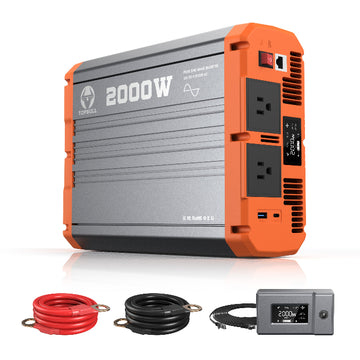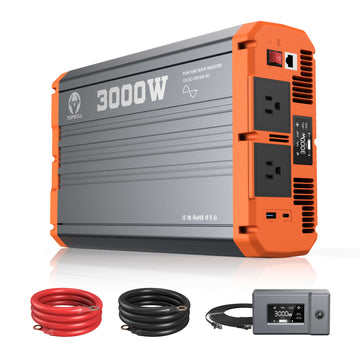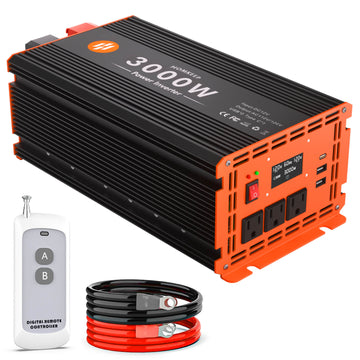Many users on forums and product review sites share common frustrations when setting up a 2000-watt inverter, overheating wires, unexpected voltage drops, and even inverter shutdowns due to improper cable selection. Choosing the right wire size, fuse, and battery cables isn't just about meeting technical specs. It directly impacts your system's safety, efficiency, and longevity.
Whether you're powering an RV, off-grid setup, or backup home system, this guide will walk you through selecting the best wire size for your 2000 watt power inverter to avoid these issues. Plus, we'll recommend a high-efficiency inverter to help you get the most out of your setup.
Related Reading:
What Can a 2000W Inverter Run? Fridges, TVs, & More!
How Many Watts Does a Portable Induction Burner Need [2025]
Factors that Affect Wire Selection for a 2000W Inverter
Choosing the correct wire size for a 2000-watt inverter involves more than just picking a thick cable. It requires understanding how electrical current flows and how different factors impact performance. The following key considerations will help ensure safe and efficient power transmission:
-
Power Demand: A 2000W inverter consumes a significant amount of current, especially in 12V systems, where the amperage is much higher compared to 24V or 48V systems. The higher the current, the thicker the wire is needed to prevent overheating and power loss.
-
AWG Standards: The American Wire Gauge (AWG) system classifies wires based on their diameter and current-carrying capacity. Lower AWG numbers indicate thicker wires, which can handle higher amperage. Selecting the right AWG rating is crucial to maintaining system efficiency and preventing excessive heat buildup.
-
Voltage Consideration: The inverter's input voltage affects wire size selection. Since power (W) = voltage (V) × current (A), a 2000W inverter at 12V draws much more current than one at 24V or 48V. This means a 12V system requires significantly thicker wires than higher-voltage systems to safely handle the load.
- Distance Impact: The longer the wire runs, the greater the resistance and voltage drop. This means that for longer cable lengths, you may need to increase the wire gauge to maintain stable voltage and prevent efficiency loss. Shorter cables are always preferable, but when long runs are unavoidable, using oversized wires ensures optimal performance.
How to Calculate the Required Wire Size for a 2000W Inverter
To determine the appropriate wire size for a 2000-watt inverter, you first need to calculate the current draw and consider the cable length. Selecting the correct gauge prevents overheating, power loss, and voltage drops, ensuring your inverter operates efficiently.
Step 1. Calculate the Current Draw
Since power (W) = voltage (V) × current (A), the current draw depends on your system's input voltage:
-
12V System: 2000W ÷ 12V = 167A
-
24V System: 2000W ÷ 24V = 83A
- 48V System: 2000W ÷ 48V = 42A
Step 2. Choose the Wire Gauge Based on Distance
Wire size isn't just about current, it also depends on the length of the cable run. Longer wires create resistance, which can cause voltage drops and reduce inverter efficiency. To avoid this:
- Use a 12V battery cable size chart to match wire gauge with both current draw and cable length.
- For longer runs, opt for thicker wires to maintain stable voltage and prevent power loss.
Recommended Wire Gauge and Battery Cable Selection
Selecting the right wire gauge and battery cables is essential for maintaining safe and efficient power delivery in a 2000W inverter system. The correct cable size depends on distance, material, and current demand.
Short vs. Long-Distance Wiring
The longer the cable run, the greater the resistance and voltage drop, which requires thicker wires to maintain efficiency:
- For short runs in 12V systems, 1/0 AWG is typically sufficient to handle the high current load safely.
- For longer runs, upgrading to 2/0 AWG reduces voltage drop and prevents power loss.
Higher-voltage inverters (24V or 48V) can use smaller wire gauges due to lower current draw, but it's still essential to consider distance when choosing the right cable.
Copper vs. Aluminum Wires
Wire material plays a significant role in conductivity and efficiency:
-
Copper cables offer better conductivity and lower resistance, making them the best choice for inverters, though they are more expensive.
- Aluminum wires are a cheaper alternative but require thicker gauges (typically one or two sizes larger) to match copper's conductivity.
3AWG vs. 5AWG Battery Inverter Cables
When selecting battery inverter cables, it's crucial to choose a wire gauge that can handle the high current demand of a 2000W inverter. While 3AWG and 5AWG wires may be sufficient for low-power applications, they are not recommended for a 2000W system due to their limited current-carrying capacity. Using undersized cables can lead to overheating, voltage drop, and potential equipment failure.
For optimal performance and safety, 1/0 AWG or larger is the recommended choice. This ensures stable power transmission, prevents overheating, and minimizes energy loss. Choosing the right battery cables not only enhances your inverter's efficiency but also protects your batteries and extends the system's lifespan.
Choosing the Right Fuse and Circuit Breaker for a 2000W Inverter
To ensure safe and reliable operation, your 2000W inverter needs proper circuit protection. Both fuses and circuit breakers play a crucial role in preventing electrical damage caused by overcurrent or short circuits.
Why Fuses Matter
A fuse acts as a safety device that protects your wiring and inverter from excessive current. If the current exceeds safe limits, the fuse blows, cutting off power to prevent overheating or fire hazards.
What Size Fuse for a 2000-Watt Inverter?
The required fuse size depends on your system voltage, as lower voltages require higher current to deliver the same power output:
-
12V System: 200A fuse
-
24V System: 100A fuse
- 48V System: 50A fuse
Breaker vs. Fuse: Which One to Choose?
Both circuit breakers and fuses serve the same purpose, but they function differently:
-
Fuses are single-use—once they blow, they must be replaced.
- Circuit breakers are resettable after tripping, making them more convenient for frequent use.
For most inverter applications, a fuse provides a simple, cost-effective solution, while a circuit breaker offers the benefit of easy resets without needing replacements. Choosing the right protection method ensures long-term safety and reliable inverter performance.
Why Choosing a High-Efficiency 2000W Inverter is Important
Selecting a high-efficiency inverter is crucial for optimizing your system's performance and ensuring safety. An efficient inverter minimizes power loss, reduces strain on your battery, and allows for the use of appropriately sized cables without unnecessary upsizing.
When choosing a 2000W inverter, consider the following essential features:
-
High Efficiency: An efficiency rating exceeding 90% ensures minimal energy loss and optimal battery utilization.
-
Pure Sine Wave Output: Delivers clean and stable electricity, suitable for sensitive electronics and appliances.
-
Intelligent Cooling System: Prevents overheating, thereby extending the lifespan of both the inverter and connected devices.
- Robust Safety Protections: Features such as overload, overvoltage, undervoltage, high temperature, short circuit, leakage, and reverse polarity protections safeguard your system.
Recommended: Topbull 2000W Pure Sine Wave Inverter
Considering these factors, the Topbull 2000W Pure Sine Wave Inverter stands out as an excellent choice. This inverter offers:
- High Efficiency: Provides 90% conversion efficiency. Provides 100% pure copper cables for minimal power loss and optimal energy conversion.
-
Comprehensive Safety: Offers seven protections, including overload, overvoltage, undervoltage, high temperature, short circuit, leakage, and reverse polarity.
-
Advanced Cooling: Dual intelligent fans and aluminum casing prevent overheating and extend durability.
-
Versatile Compatibility: Works with 12V lead-acid and lithium batteries, ideal for home backup, off-grid, and outdoor use.
- User-Friendly Design: Includes USB & Type-C ports, dual AC outlets, and a 20-foot remote for easy control.

By integrating the Topbull 2000W Pure Sine Wave Inverter into your system, you can enhance overall efficiency, reduce power losses, and ensure a stable and reliable power supply for your appliances.
Tips: If you want to learn more about inverter's working flow and the budget for purchasing it, please check out the post as follows.
12V to 120V Inverter: How It Works & What You Need to Know
How Much Does A Power Inverter Cost: Smart Buying Tips
How to Optimize Battery Cable Performance for Maximum Efficiency
To maximize your inverter's efficiency and lifespan, you need to optimize battery cable performance. Poor cable management can lead to energy losses, overheating, and voltage drops. Here's how to ensure the best performance:
-
Use Shorter Cables Whenever Possible – Longer cables create more resistance, which reduces power efficiency. Keeping cables as short as feasible helps minimize voltage drop.
-
Choose High-Quality Terminals and Connectors – Cheap or poorly crimped terminals can lead to connection failures, increased resistance, and even sparks or overheating.
- Ensure Secure Crimping and Proper Insulation – Loose or poorly crimped wires can cause unstable power transmission, leading to performance issues and potential safety hazards.
By following these best practices, you can maintain a reliable and efficient inverter system while extending the lifespan of your power setup.
Common Mistakes When Choosing Wires for a 2000W Inverter
Selecting the wrong wires can cause serious performance and safety issues. Avoid these common mistakes when wiring your 2000W inverter:
-
Assuming all 2000W inverters require the same wire size – Wire gauge depends on the system voltage (12V, 24V, or 48V), as higher voltages require less current and thinner cables.
-
Using undersized wires – Too thin cables can overheat, reduce efficiency, and potentially cause system failure. Always follow the correct wire gauge recommendations.
-
Skipping fuses or circuit breakers – Not using proper overcurrent protection increases the risk of fire hazards.
- Opting for cheap aluminum cables – While aluminum is cheaper, it has higher resistance than copper and degrades faster, leading to long-term efficiency losses.
Ensuring the right wire selection helps prevent costly mistakes, enhances safety, and maximizes your inverter's performance.
FAQs About 2000W Inverter Wiring Size
What gauge wire is needed for a 2000W inverter?
The required wire gauge depends on the system voltage and cable length:
-
12V system: use 1/0 AWG for short runs and 2/0 AWG for longer runs.
-
24V systems: 2 AWG or larger is typically sufficient.
- 48V systems: 4 AWG or larger is recommended.
How can I check if my wiring is safe?
To ensure your wiring is safe and efficient:
-
Check wire temperature – If cables become excessively hot, they may be undersized or overloaded.
- Measure voltage drop – A drop of more than 3% indicates that your cables are too thin or too long.
Conclusion
Choosing the right wire size for a 2000W inverter is essential for safe, efficient, and reliable power delivery. Undersized cables can lead to overheating and power loss, while proper wiring ensures stable operation. A high-efficiency inverter like the Topbull 2000W Pure Sine Wave Inverter minimizes power waste, reduces wiring challenges, and provides stable power output. Always use quality copper wires, secure connections, and the correct fuse size to maximize performance and safety in your inverter setup.













